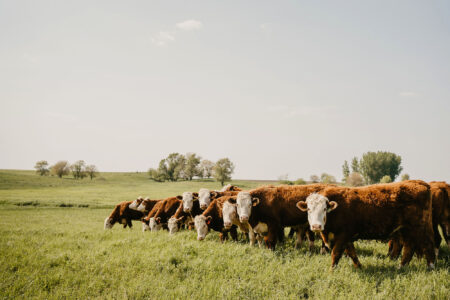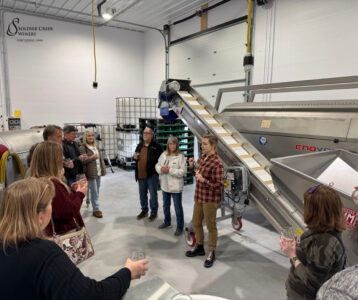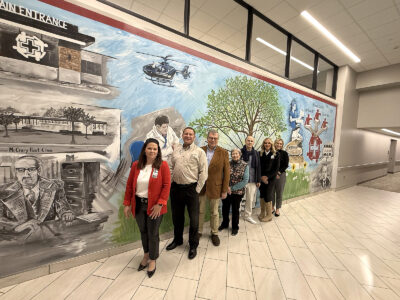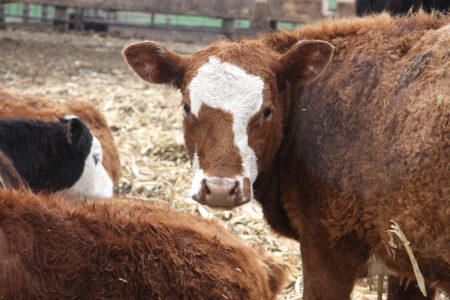Raising beef the natural way
Grand View Beef owners take pride in raising grass-fed, hormone-free, traceable Herefords
-
-Submitted photo
The Severson family raises 100% grass fed and grass finished Hereford cattle on their farm near Clarion.
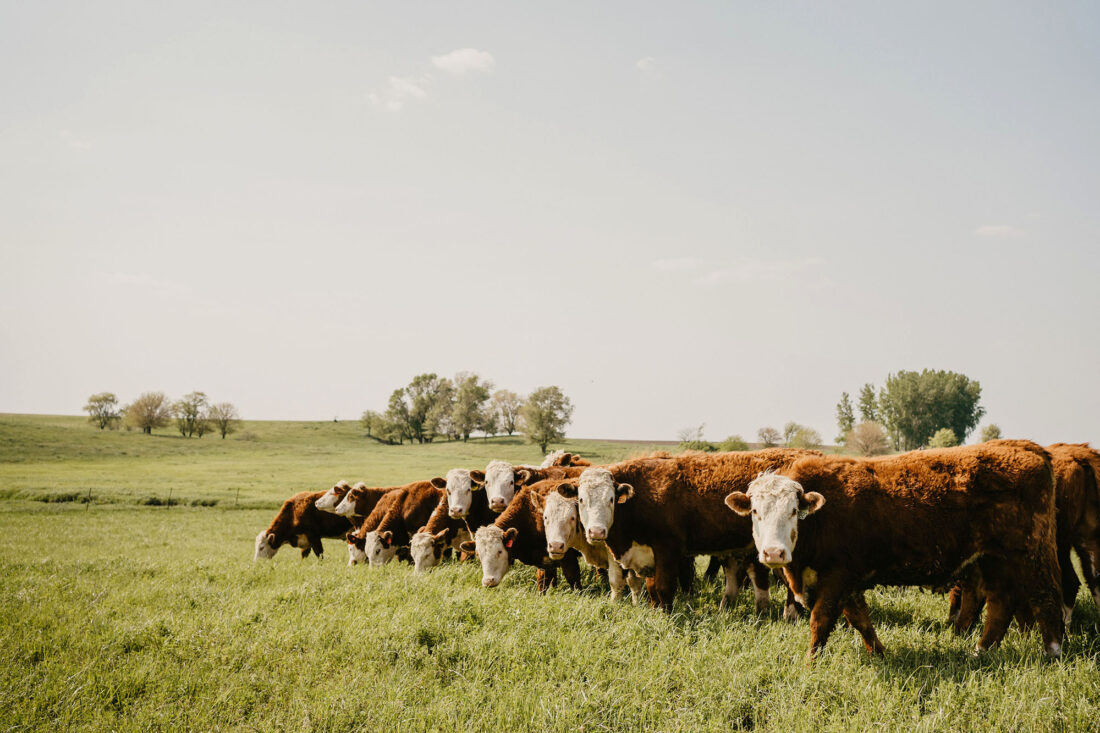
-Submitted photo
The Severson family raises 100% grass fed and grass finished Hereford cattle on their farm near Clarion.
CLARION — The Hereford cattle gracefully grazing pasture ground at Grand View Beef are not just 100% grass fed and grass finished, but also are hormone-free, as well as traceable — something that’s incredibly important to the Severson family.
The family has been farming near Clarion since 1914. Troy and Beth Severson procured their first horned Hereford herd and turned them out to pasture in 1996.
“Troy always liked the genetics and demeanor of Herefords and worked hard over the years to grow a strong herd,” said Amanda Severson, who is married to Troy and Beth’s son Knute. “When Knute and I came back and wanted to finish the calves and sell them direct-to-consumer, we knew that we would be buying horned Hereford calves from his parents.”
The plus side to starting Grand View Beef, the marketing arm for the farm, was that Amanda and Knute Severson knew exactly how the cattle were raised. There wouldn’t be much stress, if any at all, transporting them from the starting farm to their farmstead for finishing.
“(It) was as simple as a mile horseback ride. Other benefits include docility and adaptability in all situations, which results in a calm animal and leads to better meat quality,” Amanda Severson said. “They thrive in Iowa’s cold winter climate and humid hot summers, so we don’t worry about them during extreme weather events. They produce excellent quality-tasting beef.”
Amanda and Knute Severson met in Washington State while interning for the Seattle Seahawks for the 2015-2016 season, their dream jobs. But Knute realized he missed home and his family’s century farm, so he planned to return to Iowa. Amanda realized she was in love with Knute and followed him back to his hometown, where she quickly became enamored with the beauty of Iowa’s countryside.
So in 2017, Knute and Amanda Severson married and set down roots by moving into his great-grandfather’s homestead at the farm where they “remain passionately committed to stewarding God’s cattle and soil and sharing our family’s calling with you. By doing so, we hope to provide the next generation in our family the same opportunity.”
They also have welcomed three children into the world: Harbor, 5; Luella, 3; and Heston, 4 months.
Beth and Troy Severson still are heavily involved in the family operation and run the cow-calf operation with an emphasis on raising the calves for Grand View Beef. Since the beginning, they’ve focused on gentle animal husbandry practices, including moving cattle by horseback, giving access to pasture year-round and humanely handling the animals throughout their time on the ranch.
Calves are born on pasture, and a calf’s diet consists of its mother’s milk and grass, Amanda Severson said.
“Most calves on a cow/calf operation are raised from birth to weaning on a pasture. Where our beef starts to follow a different process is after weaning,” Amanda Severson said.
At approximately eight months, calves are weaned and fed hay and baleage throughout the winter.
“After weaning, conventional cattle are sent to a backgrounder and then a feedlot where they are fed a grain-based diet until they are 16 to 18 months and then harvested at around 1,400 pounds. They are typically given antibiotics to prevent illness and growth hormones to speed up the rate of gain of the cattle,” Amanda Severson said.
But not Grand View Beef cattle.
In April or May, the calves are moved to pasture and use intensive rotational grazing practices through October — or longer into December, utilizing regenerative cover crops.
“Grand View Beef is 100% grass fed and finished, meaning the cattle cannot have any grain or grain byproducts during their lifetime. May through August, our cattle are on perennial pastures where we rotationally graze them. August through January, the cattle graze cover crops or stockpiled forage. January through April, our cattle are fed a diet of alfalfa hay and some sort of fermented feed like baleage,” Amanda Severson said.
“During all seasons, the cattle have access to pasture. In the winter when the ground is frozen, we feed the cattle out on that ground so that their manure acts as a natural fertilizer. The only time they are on concrete is during a bad storm or when the ground is in the freeze/thaw period in the winter and spring. We do not use any growth hormones and only use antibiotics when an animal is ill and needs treatment as recommended by a vet,” Severson added. “All of our methods prioritize regenerative agriculture — increasing soil health, capturing carbon, increasing rainfall absorption, restoring wildlife habitat, etc., while also prioritizing the health and care of our cattle. Our cattle take 24 to 28 months to be finished and are harvested at around 1,200 pounds.”
The Seversons use a variety of different grazing methods, like cover crops following oats and stockpiled forage. They dedicate around 120 acres over the summer to rotational grazing.
“We have steadily grown the herd since we started in 2017,” Amanda Severson said. “That first year, we only processed one head of beef that we sold direct to consumer. In 2025, we’ll process more than 100 head, all sold direct.”
Lineage is critical to continually produce high quality beef. They also track and maintain genealogy and pedigree records on all of their cattle, including bulls used for breeding.
Last year, Grand View Beef’s customer demand for product surpassed the number of calves the family could raise — a great problem to have.
So the Seversons added another ranch to their operation from which they purchase 100% grass-fed calves at weaning that are raised with the exact same standards as their own family cow-calf operation. They partner with Conger Meat Market, a USDA federally inspected locker, to process the meat.
“We take great pride in our animal husbandry practices that ensure our animals remain calm and lead a very humane life,” Severson said. “When it is time for harvest, we take animals to a family-owned, USDA processor. An inspector is on site for each harvest to ensure the beef is of high quality and safe to consume.”
“Our beef is always dry-aged 14 days. This means it hangs in a humidity-controlled room with air flow at just-above-freezing temperatures after harvest for 14 days. Then it’s cut into individual cuts and flash frozen, which increases the tenderness and flavor of the meat. In comparison, most meat that you buy in the grocery store is wet aged. Meaning it is packaged immediately after harvest and then transported to the stores. This results in a milder flavor,” she added. “It comes down to consumer preference, but we love the added flavor and tenderness that comes with dry-aging meat and encourage consumers to try it and compare it to wet aged.”
Grand View Beef also offers traceability of its product as a benefit to consumers that they appreciate.
“Grand View Beef is built on the foundation of transparency with our consumers. Our customers want to know how their beef is being raised and trust where it comes from. We offer that through a variety of different ways — like sharing videos on Instagram, writing letters each month to our subscribers and offering the traceability of each cut,” Amanda Severson explained.
“Each cut of beef has a lot code in the top right corner that is traceable back to the individual animal it came from. With that lot code, we also know when that animal was born, weaned, who were the dam and sire, and any special notes on the health of that animal during its lifetime,” Severson said. “For us, it helps us make better decisions — like which sires to keep, which mothers produce good offspring, etc.”
Another thing that sets Grand View Beef apart with the lot code is that it’s on their ground beef, too.
“Our ground beef is single source — one animal. Whereas a single pound of hamburger in the grocery store can contain meat from hundreds or even a thousand different animals because large processing plants combine meat trimming to create the ground beef,” Amanda Severson said.
Breeding is kept within the family’s operations.
“Knute’s parents still own and operate the cow/calf herd today and are responsible for breeding. It is all done the natural way — with bulls. Troy purchases bulls from trusted Hereford breeders in the West and focuses on quality genetics,” Amanda Severson said.
Not only is Grand View Beef sold at the farmers markets in Ames May through September and at Farmer’s Market in the Park in Arnold’s Park Memorial Day through Labor Day, but the Seversons also sell directly to consumers.
“We started Grand View Beef in 2017 by selling at one farmer’s market in Clear Lake. Over the years, we’ve also added the Ames Main Street Farmer’s Market and Farmer’s Market in the Park in Okoboji. These markets have been so important to us as we’ve grown,” Amanda Severson said. “We have met some of our greatest customers at the markets and we’re always learning and hearing feedback from our customers about what they want from their beef producer.”
During the summer months, Grand View Farm and Ranch hosts farm-to-table dinners out in their pasture.
“As we’ve grown Grand View Beef, we’ve continued to see that there is a huge disconnect between the consumer and the farmer/rancher. These farm-to-table dinners are our way of welcoming consumers onto the ranch and sharing transparently about our way of life and giving them a chance to ask questions about how their beef is raised,” Amanda Severson said.
The evenings on the farm start with a tour of the ranch, led by the younger pair of Seversons. Then guests mingle over an appetizer before taking a seat at the long table out in the pasture where they’ll enjoy a four-course meal prepared by a guest chef, featuring in-season, local produce and a variety of Grand View Beef’s 100% grass-fed beef cuts.
The Seversons enjoy hosting farm-to-table dinners and also host private tours and some events. They even welcome school field trips.
“While attendees are dining, our cattle graze in nearby pastures. It’s a truly unique dining experience and we absolutely love hosting people,” Amanda Severson said. “The farm-to-table dinners are the primary special events we host. We also offer the dinners for private events if corporations or family/friend groups want to reserve a private dinner. We hope to add more agrotourism events in the future, especially ones that could be geared more toward families and children.
“We also host tours for organizations and educational institutions. We’ve had the opportunity to host people from as far away as Brazil and as close as our local schools,” Severson added.

